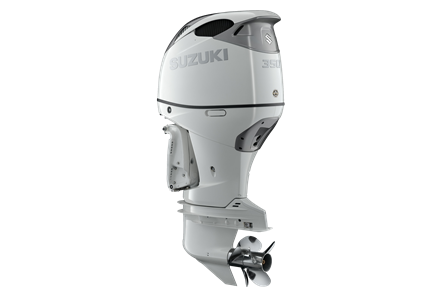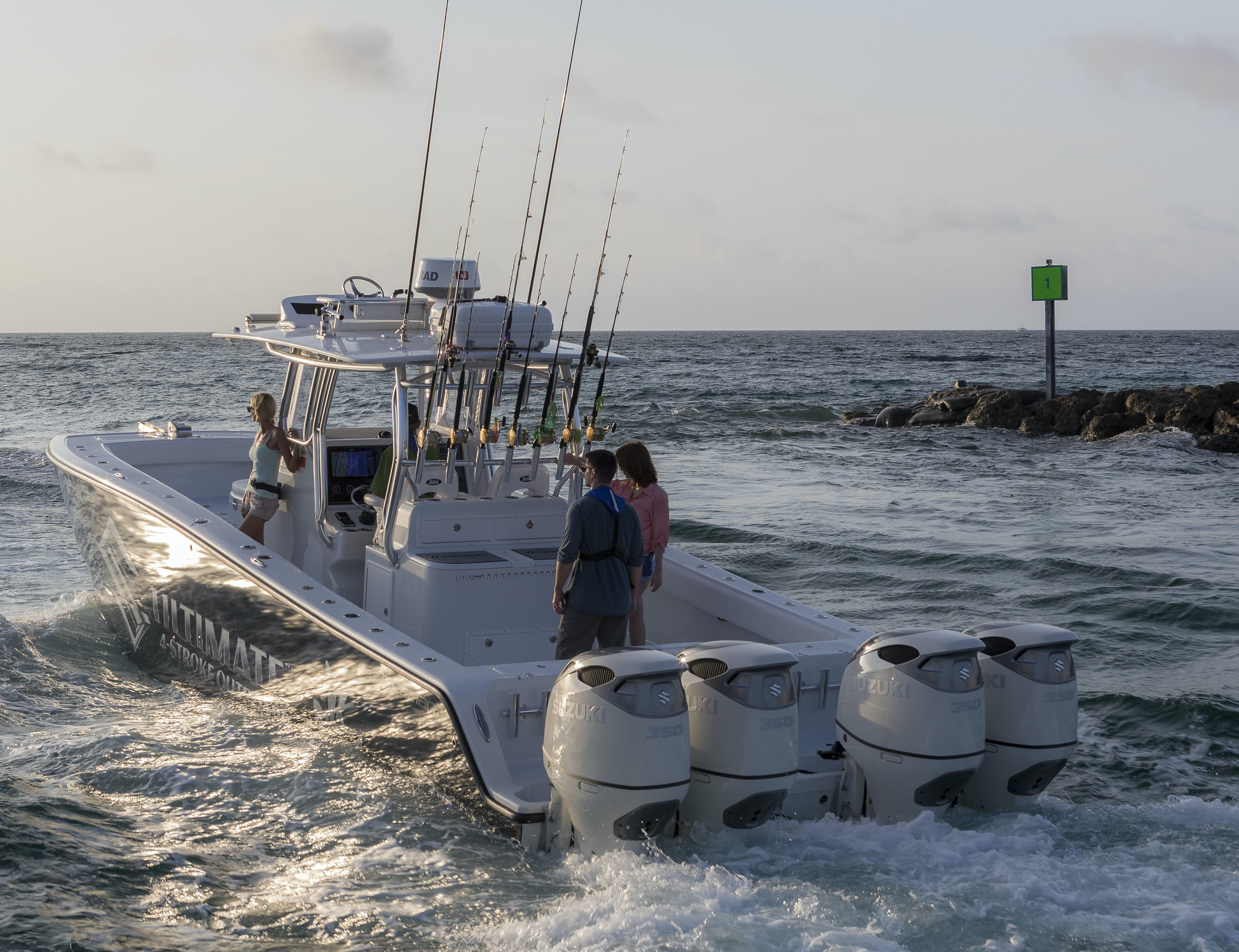Brief Summary
When it was introduced, the Suzuki DF350A was the only outboard engine with dual contra-rotating propellers. The idea was to put all that power to the water more efficiently so that’s where the extra prop comes in.
Key Features
-
Body Color – Pearl Nebular Black or Cool White
-
Engine Type – DOHC 24-Valve
-
Steering – Remote
-
Starting System – Electric - Suzuki Start System
Specifications
| Type of Engine | 4-Stroke |
|---|---|
| Number of Cylinders | 6 |
| Horse Power | 350 |
| Configuration | V-6 |
| Weight | 727.00lbs |
| Fuel Type | N/A |
| Fuel Delivery | Fuel Injected |
| Shaft Length Options |
25" (63.5 cm) Shaft Length - 727 lbs. (329.76 kg) 30" (76.2 cm) - 747 lbs. (338.83 kg) |
| Shift Throttle Control | |
| Displacement | 268.50cu in |
| Steering Control | |
| Recommended Fuel | |
| Alternator Output | 12V 54A |
| CARB Rating | |
| Engine Monitoring System |
Captain's Report
Mission Statement
Center- and dual-console boats and even pontoon and deck boats aren’t getting any smaller, so Suzuki developed the 350-hp DF350A to push larger boats more efficiently. The key to that is its twin “contra-rotating” (Suzuki’s term) stainless-steel propellers. A big motor that makes big power needs a big propeller and on a typical single-prop outboard, that means big gears in the lower unit. Suzuki engineers knew that the shape of the gearcase and the design of the propeller would be critical to the motor’s performance. A bulbous large-diameter gearcase would create hydrodynamic drag that would translate into sub-par performance.
Distributing The Load
By spreading the load over two contra-rotating stainless-steel propellers, Suzuki achieved two goals. First, the second propeller improved the motor’s overall grip on the water. Second, the torque per propeller was decreased and that allowed for smaller-diameter gears. Suzuki strengthened the gears’ materials and the heat-treating process to improve longevity and reliability. The reduction in gear diameter led to the design of a smaller, more hydrodynamic gearcase.
Another contributing factor to the sleek gearcase design is that the motor’s shifting takes place up higher in the engine’s midsection instead of down in the lower unit. This is a design that’s unique to Suzuki. The contra-rotating props also improve a boat’s overall handling and most important, its slow-speed maneuverability. The manufacturer says it sees the outboard as a great choice for powering a single-engine pontoon.
The DF350A was three years in development and is the largest outboard engine Suzuki produces. It’s a 4.4-liter (268.4 cid) V6 with a bore and stroke of 3.74” (98mm) x 3.82” (97mm). It’s one of the biggest displacements on a V6 outboard, yet it weighs 727 lbs. (329.76 kg) for the 25” (63.5 cm) shaft length and 747 lbs. (338.83 kg) for the 30” (76.2 cm) model. Maximum operating rpm range is 5700 to 6300 and the propellers for the engine have a 15 ½” (39.37 cm) diameter. Pitch ranges from 19 ½” (49.53 cm) to 31 ½” (80.01 cm).
Working our Way Up
Let’s continue our look at the DF350A with further inspection of the gearcase design. Suzuki used computational fluid dynamics and multiple sea trials to eliminate what the manufacturer called “cavitation voids,” which are areas on the gearcase housing where the water was not passing by smoothly. By eliminating those voids, Suzuki wound up with a hydrodynamically efficient lower unit with two sets of water pickups to ensure that enough cooling water gets up through the midsection to the powerhead. The main water intake is positioned just below the propshaft at the front of the gearcase with secondary inlets just above the skeg, also on the leading edge.
Working our way up, some technology that has been proven on previous Suzuki models is still in use on the DF350A. Suzuki Selective Rotation is available and it means that any model can be programmed to rotate in either direction. Also, the two-stage gear reduction results in a large reduction gear ratio (2.29:1) that gives Suzuki the ability to simultaneously prop the boat for quick acceleration and a higher top end.
Also unchanged is Suzuki’s offset driveshaft design that places the crankshaft in front of the driveshaft through the use of the upper reduction gear at the top of the engine’s vertical shaft. It moves the engine’s center of gravity forward, resulting in better weight distribution and balance, more directional stability and less vibration.
Highest Compression
Now let’s look at the powerhead and two key design features of the DF350A. Suzuki’s goal with the engine was to develop 80-hp per liter, but a block with too much displacement would have meant more weight and designers didn’t want to use a supercharger or a turbocharger to boost the power.
The solution was to increase the motor’s compression ratio to 12.0:1, the highest ratio for a production outboard engine at the time of introduction. Yamaha’s 350-hp outboard is built on a V-8 block that displaces 5.3 liters (323.4 cubic inches) and has a compression ratio of 9.6:1. A high compression ratio can often make an engine prone to knocking, so Suzuki developed new fuel-injection and air-intake systems to work with the DF350A.
One of the best ways to prevent knocking is to keep the air-fuel mixture as cool as possible and finely atomized when it’s injected into the cylinder. To keep the air cool as it flows to the injectors, Suzuki developed a Dual Louver System on the DF350A’s cowling, designing blades with a dogleg design to capture and deflect water particles away from the air in the intake flow. The outer row of blades removes the spray from the boat and the inner louvers capture and prevent remaining mist, keeping water out of the combustion process. The intake air is free of moisture and Suzuki says it never gets hotter than 10 degrees above the ambient temperature.
Fuel Delivery
For the DF350A, Suzuki developed a dual-injector system with two smaller fuel injectors per cylinder. This provides finer and more precise atomization of the fuel at the most efficient angle before it’s injected into the combustion chamber.
The pistons were also re-designed to better withstand the more combustive forces of the high-compression engine. The piston surface is shot-peened, which creates fine dimples on the surface to evenly distribute the pressure created during combustion. The connecting rods and bearings have also been beefed up.
Observations
With the higher compression, the DF350A runs on 90-octane fuel. The powerhead has a 55-degree cylinder bank and that means the engine can still fit on 27” (68.58 cm) centers when installed in a multi-motor configuration. That and the fact that the motor takes conventional hydraulic steering make the DF350A a good candidate for repowering. Suzuki offers the engine with a joystick system from SeaStar Solutions and can add SeaStation position keeping. Suzuki pairs the DF350A with its C10 helm display and it can cross-reference with virtually any instrument that is NMEA 2000 compliant. The outboard is available in black or white.
While it most likely is used on fishing boats like center- and dual consoles, the Suzuki DF350A has shown up on pontoons, deck boats and even some family cruisers that have been designed for outboard power. The engine is also coveted in the aftermarket repower market where owners are actually pulling out diesel inboards and replacing them with a pair of DF350As on brackets.



